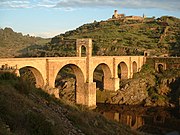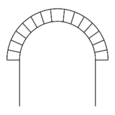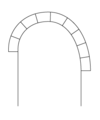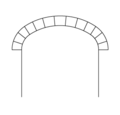Arch
From Wikipedia, the free encyclopedia
| This article is missing citations or needs footnotes. Please help add inline citations to guard against copyright violations and factual inaccuracies. (December 2007) |
An arch is a structure that spans a space while supporting weight (e.g. a doorway in a stone wall). Arches appeared as early as the 2nd millennium BC in Mesopotamian brick architecture, but their systematic use started with the Ancient Romans who were the first to apply the technique to a wide range of structures.[1]
Contents |
[edit] History
Arches were known by the Mesopotamian, Urartian, Harappan, Egyptian, Babylonian, Greek and Assyrian civilizations, but their use was infrequent and mostly confined to underground structures such as drains where the problem of lateral thrust is greatly diminished.
The ancient Romans learned the arch from the Etruscans, refined it and were the first builders to tap its full potential for above ground buildings:
The Romans were the first builders in Europe, perhaps the first in the world, fully to appreciate the advantages of the arch, the vault and the dome.[1]
Throughout the Roman empire, their engineers erected arch structures such as bridges, aqueducts, and gates. They also introduced the triumphal arch as a military monument. Vaults began to be used for roofing large interior spaces such as halls and temples, a function which was also assumed by domed structures from the 1st century BC onwards.
The Roman arch is semicircular, and built from an odd number of arch bricks (called voussoirs). An odd number of bricks is required for there to be a capstone or keystone, the topmost stone in the arch. The Roman arch's shape is the simplest to build, but not the strongest. There is a tendency for the sides to bulge outwards, which must be counteracted by an added weight of masonry to push them inwards. The Romans used this type of semicircular arch freely in many of their secular structures such as aqueducts, palaces and amphitheaters.[citation needed]
The semicircular arch was followed in Europe by the pointed Gothic arch or ogive (derived from the Islamic pointed arch in Moorish Spain), whose centreline more closely followed the forces of compression and which was therefore stronger. The semicircular arch can be flattened to make an elliptical arch as in the Ponte Santa Trinita. The parabolic and catenary arches are now known to be the theoretically strongest forms. Parabolic arches were introduced in construction by the Spanish architect Antoni Gaudí, who admired the structural system of Gothic style, but for the buttresses, which he termed “architectural crutches”. The catenary and parabolic arches carry all horizontal thrust to the foundation and so do not need additional elements.
The horseshoe arch is based on the semicircular arch, but its lower ends are extended further round the circle until they start to converge. The first examples known are carved into rock in India in the first century AD, while the first known built horseshoe arches are known from Aksum (modern day Ethiopia and Eritrea) from around the 3rd–4th century, around the same time as the earliest contemporary examples in Syria, suggesting either an Aksumite or Syrian origin for the type of arch.[2] It was used in Spanish Visigothic architecture, Islamic architecture and mudéjar architecture, as in the Great Mosque of Damascus and in later Moorish buildings. It was used for decoration rather than for strength.
Across the ocean in Mexico and Central America, Mesoamerican civilizations created various types of corbelled arches, such as with the interior tunnels in the Great Pyramid of Cholula and the many styles of corbelled arches built by the Mayan civilization. In Peru, the Inca civilization used a trapezoidal arch in their architecture.
The arch is still used today in some modern structures such as bridges.
[edit] Construction
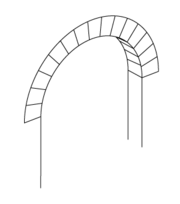
An arch requires all of its elements to hold it together, raising the question of how an arch is constructed. One answer is to build a frame (historically, of wood) which exactly follows the form of the underside of the arch. This is known as a centre or centring. The voussoirs are laid on it until the arch is complete and self-supporting. For an arch higher than head height, scaffolding would in any case be required by the builders, so the scaffolding can be combined with the arch support. Occasionally arches would fall down when the frame was removed if construction or planning had been incorrect. (The A85 bridge at Dalmally, Scotland suffered this fate on its first attempt, in the 1940s). The interior and lower line or curve of an arch is known as the intrados.
Old arches sometimes need reinforcement due to decay of the keystones, known as bald arch.
The gallery shows arch forms displayed in roughly the order in which they were developed.
|
Round arch or Semi-circular arch |
Unequal round arch or Rampant round arch |
||
|
Shouldered flat arch -see also jack arch |
Three-foiled cusped arch |
||
[edit] Technical aspects

The arch is significant because, in theory at least, it provides a structure which eliminates tensile stresses in spanning an open space. All the forces are resolved into compressive stresses. This is useful because several of the available building materials such as stone, cast iron and concrete can strongly resist compression but are very weak when tension, shear or torsional stress is applied to them. By using the arch configuration, significant spans can be achieved. This is because all the compressive forces hold it together in a state of equilibrium. This even applies to frictionless surfaces. However, one downside is that an arch pushes outward at the base, and this needs to be restrained in some way, either with heavy sides and friction or angled cuts into bedrock or similar.
This same principle holds when the force acting on the arch is not vertical such as in spanning a doorway, but horizontal, such as in arched retaining walls or dams.
Even when using concrete, where the structure may be monolithic, the principle of the arch is used so as to benefit from the concrete's strength in resisting compressive stress. Where any other form of stress is raised, it has to be resisted by carefully placed reinforcement rods or fibres. (See Arch bridge.)
[edit] Other types

A blind arch is an arch infilled with solid construction so it cannot function as a window, door, or passageway.
A dome is a three-dimensional application of the arch, rotated about the center axis. Igloos are notable vernacular structures making use of domes.
Natural rock formations may also be referred to as arches. These natural arches are formed by erosion rather than being carved or constructed by man. See Arches National Park for examples.
A special form of the arch is the triumphal arch, usually built to celebrate a victory in war. A famous example is the Arc de Triomphe in Paris, France.
A vault is an application of the arch extended horizontally in two dimensions; the groin vault is the intersection of two vaults.
[edit] Gallery
|
Arch of Constantine, Rome, Italy commemorating a victory by Constantine I in 312 AD |
The Gateway Arch in Saint Louis, Missouri; a sculpture based on a catenary arch |
Doubled round archivolts - Igreja de Nossa Senhora da Assunção, Linhares da Beira, Portugal. |
|
|
Stonework arches seen in a ruined stonework building - Burg Lippspringe, Germany |
Several arches at the Casa Simón Bolívar in Havana, Cuba |
Arches in the nave of the church in monastery of Alcobaça, Portugal |
|
|
thumb|left|The Arc de Triomphe, Paris; a 19th century triumphal arch modeled on the classical Roman design |
thumb|left|The Second Wembley Stadium, in London, built in 2007 |
[edit] References
| Wikimedia Commons has media related to: Arch |
- ^ a b Robertson, D.S.: Greek and Roman Architecture, 2nd edn., Cambridge 1943, p.231
- ^ Stuart Munro-Hay, Aksum: A Civilization of Late Antiquity. Edinburgh: University Press. 1991. ISBN 0-7486-0106-6, p.111.
- Roth, Leland M (1993). Understanding Architecture: Its Elements History and Meaning. Oxford, UK: Westview Press. ISBN 0-06-430158-3. pp. 27-8
[edit] See also
[edit] External links
- Oldest Known Arch In The World Photography by a U.S. soldier serving in Iraq.
- DIYinfo.org's Constructing Brick Arches Wiki - A wiki on how to construct brick arches around the house
- DIYinfo.org's Constructing Timber Framed Arches Wiki - Similar to the brick arches but extra information for timber arches

